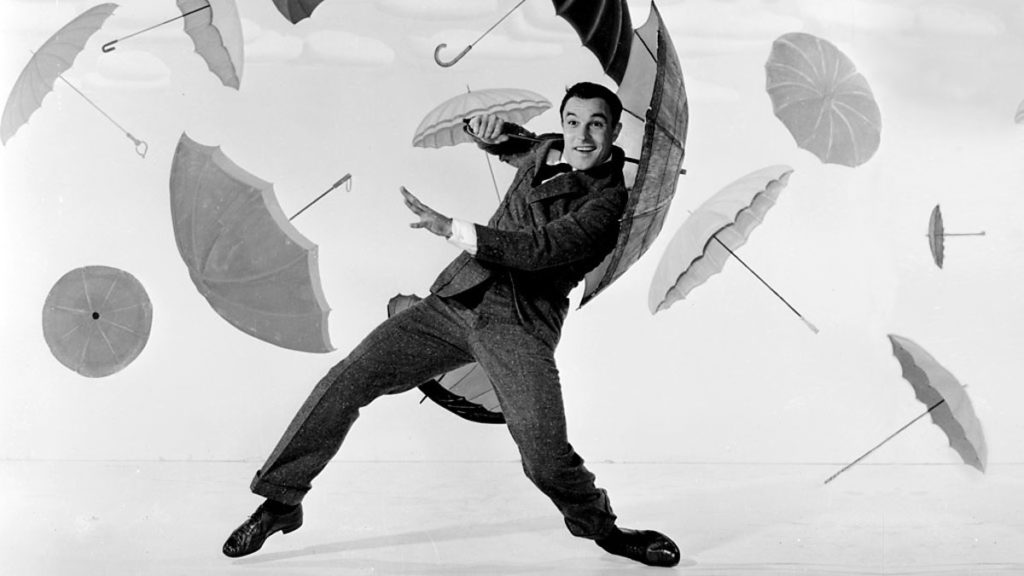“Why don’t you and me do some fancy stepping tonight?”
—Gabey (Gene Kelly) to Ivy (Vera-Ellen) in On the Town
Grab your tap shoes: today is Gene Kelly’s 105th birthday. I’ve been a Kelly fan almost since infancy and after decades of assiduous viewing, it’s easier for me to name the musicals I haven’t seen rather than the ones I have.
Gene Kelly made his screen debut opposite Judy Garland in Busby Berkeley’s For Me and My Gal (1942) and appeared in nearly 30 musicals over the next 50 years. He played non-musical parts too—including an exuberant d’Artagnan in the 1948 version of The Three Musketeers and a caustic journalist in Inherit the Wind—but none eclipsed the sight of him dancing.
Kelly’s style was earthy, muscular, athletic—a combination of power and grace that made him light on his feet, yet close to the ground. He danced with Cyd Charisse, Leslie Caron, Debbie Reynolds, Vera-Ellen, Rita Hayworth, Mitzi Gaynor and Jerry the Mouse, but unlike Fred Astaire and Judy Garland, the other two thirds of MGM’s triumvirate, he never had a regular partner. He was always a dancer apart.
Trying to explain why Kelly is magnificent is like trying to explain chocolate or Rhapsody in Blue. The only solution is to watch him in motion. (All the choreography is Kelly’s save one notable exception.)
‘Moses Supposes’, Singin’ in the Rain (1952)
A lifetime of friendship condensed into just over three minutes. Kelly and Donald O’Connor, as best friends Don Lockwood and Cosmo Brown, dance with a riotous sense of play, twirling curtains and hopping off furniture like teenagers let loose in an improv class. Nothing on the set goes to waste, not even a wastepaper basket. They are so perfectly in sync, you believe they’ve been dancing together since they were boys. Why MGM didn’t think this was a partnership worth repeating remains a mystery to me.
‘The Broadway Ballet’, Singin’ in the Rain (1952)
Two leaps, a slide and Cyd Charisse’s leg. Kelly had a penchant for elaborate ballet sequences and this—a 13-minute film within a film about a young dancer on Broadway—is one of his best. He plays a hoofer whose desire to dance lands him in a Jazz Age speakeasy and at the feet of Charisse’s moll. She coils around him, teasingly, her flapper dress trailing green tendrils. Exasperated, he pulls her close and she leaps into his arms. You can almost hear the celluloid sizzling.
‘I Like Myself’, It’s Always Fair Weather (1955)
Gene Kelly tap dancing. In roller skates. That is all.
‘The Heather on the Hill’, Brigadoon (1954)
No Scot can sit through Brigadoon without complaint. The painfully artificial sets, accentuated by CinemaScope lenses and the presence of a bemused Highland cow. The inexplicably large number of pipers and drummers concentrated in a tiny village. The accents. And yet there’s this pas de deux, in which Tommy (Kelly), an American on holiday, courts Fiona (Cyd Charisse), an ethereal Scottish lass with a secret. For one shining moment, Kelly and Charisse are enough to make you believe in magic.
‘Niña’, The Pirate (1948)
Seraphin (Kelly) rolls into town with his travelling circus and flirts with nearly every woman in sight, clambering up walls and swinging across balconies in an impressive display of athleticism that’s part-seduction, part-parkour. The Pirate doesn’t have much of a plot and was a damp squib at the box office, but this number sets off fireworks. See the first half here. The second half is below.
‘An American in Paris’, An American in Paris (1951)
Seventeen minutes of sublime beauty, fashioned from George Gershwin’s tone poem of the same name. Powell and Pressburger’s The Red Shoes widened the horizons of ballet on film and Kelly wanted to go further, choreographing the most ambitious musical sequence in MGM history. The ballet was shot after the rest of the film was complete. Preparations were so intricate, director Vincente Minnelli shot an entire film, Father’s Little Dividend, before the set and choreography were ready.
On a lonely balcony, Jerry (Kelly), an American in Paris, dreams of his lost love, Lise (Leslie Caron). Jerry is a painter and in his mind’s eye, Paris bursts into life in the style of artists including Pierre-Auguste Renoir and Toulouse-Lautrec. In a vision of the fountains at the Place de la Concorde, inspired by Raoul Dufy, Jerry takes Lise gently in his arms, two silhouettes swaying in the amber fog. When Kelly and producer Arthur Freed screened the film for Dufy, the artist was moved to tears and asked to see the ballet again.
An American in Paris won the Academy Award for Best Picture, only the third musical to do so. Kelly was awarded an Academy Honorary Award for “his versatility as an actor, singer, director and dancer, and specifically for his brilliant achievements in the art of choreography on film”. It was the only Oscar he ever received.
‘The Babbitt and the Bromide’, Ziegfeld Follies (1946)
What happens when you put two of the greatest dancers in the history of cinema together on screen? This number: a three-part song and dance contest performed and choreographed by both Kelly and Fred Astaire. The routine suits them both: jazzy and loose, with a palpable sense of fun. It is the only time they ever danced together on camera in their prime.
‘Singin’ in the Rain’, Singin’ in the Rain (1952)
Joy incarnate.

A truly joyous tribute to an extraordinary talent.
Thank you!